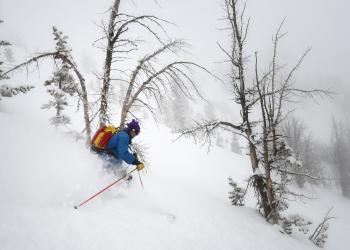Safety and Outdoor Ethics
Spending time outdoors is a healthy way to stay active, bond with family, and reduce stress. However, it’s important for all of us to take personal responsibility in keeping ourselves and our favorite outdoor places safe and preserve them for generations to come. Follow the tenants of Leave No Trace. Make sure to pack safety equipment such as bear spray, a personal flotation device (PFD), climbing gear, helmets, etc., so that you are prepared when recreating on the Bridger-Teton. Pay special attention to Alerts, closures, and Current Conditions so that you are aware of possible fire restrictions, activities, pet regulations, etc. Above all else, leave our precious recreation spots better than you found them by disposing of all waste properly, put all campfires dead out before leaving them unattended, and be considerate of others.
Leave No Trace

The 7 Principles of Leave No Trace provide an easily understood framework of minimum impact practices for anyone visiting the outdoors.
Bridger-Teton Avalanche Center

Fresh powder turns are not worth your life! Those venturing into the mountains should use careful snowpack assessment and good terrain choices. Before heading into the backcountry, always check the Bridger-Teton Avalanche Center for current conditions.
Be Bear Wise: Keep Bears Wild & People Safe

For the safety of humans and bears alike, the Bridger-Teton National Forest is committed to providing readily available information to Forest visitors about food storage regulations. This will help minimize negative interactions between people and bears when recreating in bear country. We encourage you to take the pledge to educate yourself for your safety and the safety of bears!
Play Clean Go

Keep the adventure, stop invasive species in your tracks.
Clean, Drain, Dry to Prevent AIS

Watercraft inspections are crucial as the first line of defense against aquatic invasive species (AIS) entering Wyoming’s waters.
Gold Panning
There are just a handful of areas where no gold panning/ sluicing is allowed on the Bridger-Teton National Forest and those areas include: Wilderness/Wilderness Study Areas, almost the entire greater Wyoming/Salt River Range (including Greys River, Snake River, and Hoback River), Granite Creek, and most administrative/recreation sites.
Some areas open to mineral entry on the Bridger-Teton National Forest include: Gros Ventre River and tributaries, Green River and tributaries, Buffalo Fork and tributaries, Pacific Creek, Ditch Creek, Cache Creek, Game Creek and creeks of the Wind River Front (portions of these outside of Wilderness).
There aren't many mining claims on the Bridger-Teton National Forest, but you will need to know if mining claims exist where you plan to prospect. If so, permission from the claimant is needed. You can research this with BLM's Mineral & Land Recordation System (MLRS) online. The master title plats found there will also show which lands have been withdrawn from mineral entry.
You will need to submit a Notice of Intent to the Forest Service if sluicing is motorized in any way.
If you have more questions, our Forest Geologist is happy to help!
Gold panning on Wild and scenic Rivers
Nearly all Bridger-Teton National Forest land is open and available for prospecting and mining; however, some areas along streams have already been “staked” with previous placer claims. Those are places where permission by the stakeholder is required and newcomers are not necessarily welcomed. Other areas have been withdrawn from mineral mining including gold panning.
Historically, there are areas in the headwaters that were prospected and some had claims worked at a commercial scale decades ago, but ultimately failed. There was plenty of flake gold, but it proved to be near impossible to separate the clay from said flakes. Learn more about Prospectors & Miners.
Can individuals pan or suction dredge for gold in designated wild and scenic rivers?
It depends on whether the collecting activity is commercial or noncommercial in nature and subject to river-administering agency regulation. Mining under the 1872 mining law is a commercial and business activity tied to valid existing rights of claims and is regulated as such (36 CFR 228, 43 CFR 3809, 8365, et al). Existing claims are allowed to be worked in some places. New claims may not be issued.
Non-commercial mineral collecting for recreational purposes (e.g., hobby collecting, rock-hounding, gold panning, sluicing, or dredging) may be authorized by the U.S. Forest Service depending on the amounts collected, size and scale of activity, resource values impacted, and river management objectives. Most designated Wild and Scenic Rivers are restricted. The areas allowed are Gros Ventre River and tributaries, Buffalo Fork and tributaries, and Pacific Creek.
Collecting is also subject to state, local, and other federal regulations.
Helpful Links
Most Snake River Headwaters Wild and Scenic designated river sections here on the Bridger-Teton National Forest have been withdrawn from mineral entry and leasing to protect resource values. Those areas withdrawn from mineral entry are not open to mining, prospecting or mineral removal (except for existing claims). Please contact our Recreation and Wild & Scenic Rivers manager if you have additional Wild and Scenic River Management questions.
Metal Detecting
Metal detectors may be used on public lands in areas that do not contain or would not reasonably be expected to contain archaeological or historical resources.
Metal detector use is allowed in developed campgrounds and picnic areas if they are not specifically closed to such activity. It is permissible to collect coins, but prospecting for gold would be subject to mining laws. However, you should know that agencies have not identified every archaeological site on public lands, so it is possible you may run into such remains that have not yet been discovered. Archaeological remains on federal land, known or unknown, are protected under law. If you were to discover such remains, you should leave them undisturbed, stop metal detecting in that area, and notify the local FS office.
Code of Federal Regulations, 36 CFR 261.9: "The following are prohibited: (g) digging in, excavating, disturbing, injuring, destroying, or in any way damaging any prehistoric, historic, or archaeological resources, structure, site, artifact, or property. (h) Removing any prehistoric, historic, or archaeological resources, structure, site, artifact, property." (Historic means older than 50 years.) USDA Forest
ARPA, 16 U.S.C. 470cc: "No person may excavate, remove, damage, or otherwise alter or deface or attempt to excavate, remove, damage or otherwise alter or deface any archaeological resources located on public lands or Indian lands unless such activity is pursuant to a permit. . ."
Shooting sports activities have been enjoyed for generations and are welcomed on National Forest System lands.
Both state and federal laws apply on the Bridger-Teton National Forest, so you also need to check on the Wyoming laws and county ordinances which may apply to the area you will be visiting. You also need to be in compliance with any general federal laws and regulations about weapons (Bureau of Alcohol, Tobacco, Firearms and Explosives (ATF), etc).
The only regulations specific to use of weapons imposed by the Forest Service is that you cannot discharge a weapon within 150 yards of any structure/development or occupied area, within or into a cave, across or on a road or body of water, or in any manner that endangers a person. You also cannot use any tracer or incendiary ammunition. Forest Service regulations require that you also comply with all State laws regarding the use of firearms while hunting.
There is no special order or provision that prohibits firearms in the three Wilderness areas of the Bridger –Teton (Gros Ventre, Teton, and Bridger). Also, if you chose to shoot clay pigeons, the debris and remnants from shattered shells must be removed. Shooting paint ball guns is not allowed on the Forest.
We encourage you to use designated shooting areas or ranges. However, if you choose to shoot in an undesignated area, please ensure that your shooting does not damage any facilities or natural resources, disrupt other uses, or endanger public safety, and ensure you remove any targets, wads, shells, brass and other refuse with you when you leave. Be sure your shooting target area is free of rocks, as wildfires have resulting from sparks from ricochets. Be responsible for your action and follow outdoor ethics, in other words always, Leave No Trace and Tread Lightly! on federal lands.
It is also a good idea regardless, just to contact the local Forest Service District or Forest Offices in advance of your visit to ask the same question, as they are more aware of local ranges and other opportunities, local orders or restrictions, issues and special conditions that may affect you.

In the Bridger-Teton National Forest, you can collect up to one gallon of mushrooms per person, per day, for personal use, but commercial harvesting is not permitted.
Here's a more detailed breakdown:
- Personal Use: You can collect up to one gallon of mushrooms per person, per day for personal use.
- Commercial Harvesting: Commercial mushroom harvesting is not authorized on the Bridger-Teton National Forest. If commercial permits are offered, they are available at the local Ranger District Office.
- Foraging Guidelines:
- Leave no trace; don't drive off-road or litter.
- Minimize use around trailheads and campgrounds.
- Obey stay limits in the national forest.
- Foraging mushrooms is not permitted in wilderness areas.
- Always use a knife or scissors to cut the stem, rather than pulling the mushroom from the ground, so you don’t disturb neighboring mycelium.
- Never pick all the mushrooms in one area. Pick 60 percent and leave 40, then move on. Wild mushrooms spread by the dispersal of spores, so leave a few so they can continue to drop spores and others can enjoy them for years to come.
- Clean the cap on the spot with an artist’s brush. Rinsing mushrooms with water will cause them to deteriorate quickly, like a berry.
- Place your finds in a mesh bag, or basket to allow dirt to fall through and not plastic or paper because they can rot.
- When to Look for Morels: Look for the first tree buds and a few warm days as a sign that the morel mushroom hunting season has begun.
- Where to Look: Treed areas, burn sites, and areas around oak, elm, ash, and aspen trees are good places to look for morels.
- Collect up to one gallon of mushrooms a day for personal use (in Bridger-Teton National Forest).
- Leave no trace. Don't drive off road. Don't litter.
- Minimize use around trailheads and campgrounds.
- Obey stay limits in the national forest.
- Foraging mushrooms is not permitted in wilderness areas.
The sterile environment in recently burned areas is super receptive to fertilization. You need to be hyper-vigilant about spreading noxious weeds. Wash and clean your equipment, including the soles of shoes, before you go out as these areas are ready to accept any type of vegetation and seeds.


